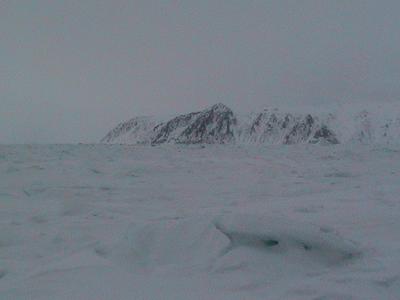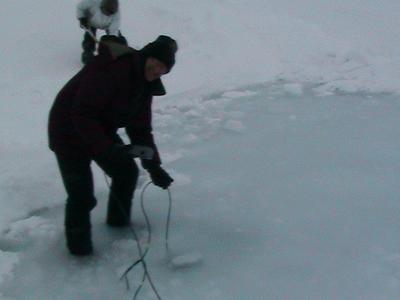1 April, 2003
Science On Ice
Today I got my first real taste of working on the
ice away from the science shack area. Jerry, Jim and I
loaded up the snowmobile and headed south of the high
school and the helicopter pad.
After taking a GPS (Global Positioning System)
reading from the shore area we measured a distance of
250 feet from the shoreline and began using the augers
to drill. We use two auger sizes, a four-foot long and
a seven-foot long. The four-foot auger is used first
and when it has reached its maximum depth it is
removed, the hole cleared of ice and the seven-foot
auger is inserted. The seven-foot auger is used until
we reach the seawater. Occasionally, on thicker ice
areas, we are forced to use shovels and the smaller
auger to dig out a large hole and begin drilling from
the bottom of the hole. This task of digging before we
drill is not, I repeat not a fun task especially when
you have five layers of weather gear on.
Once we drill through the ice and reach the
seawater the hole is scooped free of ice, slush and
any floating debris. A probe is then lowered into the
hole approximately ten meters and data is collected on
the waters salinity level, dissolved oxygen and the
temperature. As a final step we take a GPS reading of
the site so that we can return to collect more data at
a later date.
We continued this process until we reached about
3000 feet from shore, near the International Dateline.
That is our absolute limit of how far we can go before
we either reach the landing strip or Russian
territory. We spent a little over five hours on the
ice and to be quite honest my gear kept me very warm
and dry.
An interesting thing happened while we were drilling
the last hole in the ice a snowstorm swept in creating
a white out. Moderately high wind and snow limited our
visibility to around 20 feet. Getting back to the
island was slow and difficult against the wind and
snow blowing directly at us but we eventually made it
back without incident.
It was interesting and a little exciting working on
the ice knowing that the cold, moving ocean is beneath
your feet. While at our farthest point I got a sense
of being on an alien world. Chunks of ice of all sizes
piled around you and covered with snow, two big rocky
islands visible east and west appear completely
uninhabited from our viewpoint, and only the sound of
the wind. Although extremely tiring it was an awesome
experience and day.

A view of Big Diomede, Russia near our last drill site of the day.

Collecting sensor data on salinity, dissolved oxygen and temperature in one of the drill holes.
Contact the TEA in the field at
.
If you cannot connect through your browser, copy the
TEA's e-mail address in the "To:" line of
your favorite e-mail package.
|
